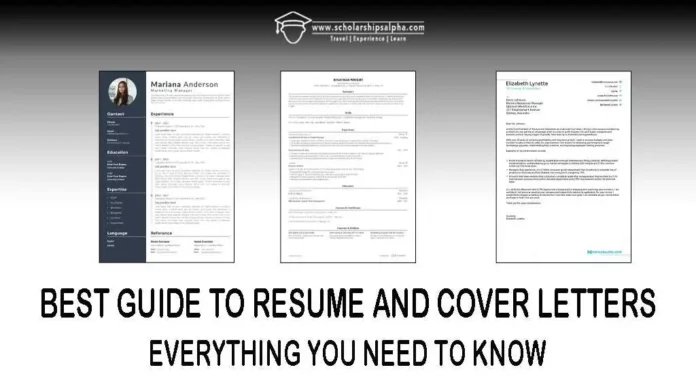Best Guide To Resume And Cover Letters. Did you know? To get a job, you need to have a good resume and cover letter. Learn how these two documents differ and how to stand out from other job candidates. Getting a job can be challenging for even the most experienced professionals. Much of this difficulty stems from the number of applications companies receive for a single position. According to Glassdoor, the average corporate job opening attracts at least 250 candidates.
Candidates need to stand out by having a strong CV and cover letter. The greatest cover letters and resumes condense your qualifications, pertinent experiences, objectives, and successes. Before deciding whether to send an applicant forward, recruiters spend just 7.4 seconds on average examining resumes. Gaining an interview and, ideally, a job depends on having a well-written, simple-to-read CV and an interesting cover letter.
This article will explain the purpose of resumes and cover letters, how to structure them, and practical advice to bear in mind while you draught your documents.
Resume and Cover Letters: What’s the Difference?
In the United States, resumes and cover letters make up the majority of job applications. But how do a cover letter and resume differ specifically from one another?
A resume gives a summary of your qualifications, training, experience, and noteworthy accomplishments. This document, which is typically one page long, has a bulleted list of accomplishments that highlights your experiences that are most pertinent to the position you’re applying for.
A cover letter, on the other hand, is a more conversational letter that introduces you, explains why you’re applying for a particular job, and outlines your qualifications for the position. You can also showcase your writing skills and add a more personal touch in this text. Employers for many Jobs request candidates send a cover letter along with their CV.
Format of Resume
Formatting a resume can take time. There are three main types of resume formats:
- Chronological
- Functional
- Combination
Below, we look at the pros and cons of each resume formatting type.
As always, job-seekers should take the time to tailor their resumes to each position they apply to. Remember that employers value personalised applications because they reflect a strong worth ethic, attention to detail, and creativity.
1. Chronological
The chronological (or reverse chronological) resume format is the most widely used and highlights professional experiences in reverse chronological order, beginning with the most recent and ending with the oldest. Job seekers with relevant, continuous work histories are most suited for this style of CV.
Each job should have 3-5 bullet points outlining your main responsibilities and greatest achievements. Use quantitative accomplishments and an action verb at the beginning of each bullet.
2. Functional
The functional resume format is perfect for recent college graduates, career changers, and professionals with gaps in their employment history since it places more focus on skills than experience.
This format starts the resume with a personal statement that summarises the subsequent list of pertinent employment skills. You should also describe any in-demand hard abilities you possess, such as command of computer programmes or data analysis tools, even if it’s important to highlight your valuable soft skills. You will then give a brief summary of your education, followed by a list of your recent, relevant work experiences.
3. Combination
This resume style, as its name implies, combines work experience with pertinent abilities to provide a versatile document appropriate for individuals with substantial experience in their field.
The combination resume starts with a thorough skills section, just like the functional resume, and then lists your previous jobs in reverse chronological order. Jobs included should demonstrate your abilities in use, supported by quantifiable successes.
Because it includes so many different components, job seekers frequently find that creating a combo CV is the most challenging. Consider limiting your list of qualifications to those that are pertinent to the position you’re applying for to simplify the process.
How to Make a Cover Letter for a Resume
There is a comparatively rigid format for cover letters. Due to this regularity, hiring managers and recruiters can immediately spot important characteristics while screening potential employees. The essential components of a cover letter for a job are covered below.
Heading
The heading should contain contact info for both you and the company to which you’re applying. Be sure to separate these elements clearly by presenting each item on a new line.
Here’s what to include:
- Your Contact Information: Tthis contains your full name, phone number, email address, and residential address (alternatively, you can just include your city and state). You can also connect to your LinkedIn page, online portfolio, or professional website. Use a formal email account, preferably one that has both your first and last name (such as scholarships.alpha@email.com).
- Date: This is the date you submit your job application. In general, the date should be on its own line after your contact information.
- Recipient’s Contact Information: Traditionally, this consists of the company’s name, address, phone number, and email address.
Greeting
The introduction begins with a polite salutation like “Dear,” is followed by the hiring manager’s or department head’s complete name, and is punctuated with a comma or colon. In general, job seekers can locate the correct recipient’s name by visiting the corporate website or contacting the front office. It is preferable to avoid using gender-specific titles like Mr., Ms., and Mrs.
Introduction and Body
You have two to three paragraphs in the cover letter to describe your professional background and differentiate yourself from other applicants. As a result, it’s critical to be succinct while including the most relevant, striking details.
The first paragraph, or introduction, should highlight your intention to apply, mentioning the organisation and the position you’re seeking in particular. The second and third paragraphs should include a summary of your qualifications, job history, and most important talents.
A solid rule of thumb is to put into more detail on significant accomplishments and talents that you weren’t able to cover in-depth on your resume.
Conclusion
The goal of the concluding paragraph is to connect your special skill set to the company’s needs. In essence, it should emphasise the key factors that make you the greatest applicant for the job. This paragraph should demonstrate your genuine passion for the position and openness to going into deeper information about your qualifications.
Closing
Because a resume is a form of professional correspondence, be sure to sign off with a formal closing like “Sincerely,” “Regards,” or “Best,” followed by your full name.
Key Resume and Cover Letters Tips
Many college students and recent grads know little about job hunting and what the process entails. Use the following resume and cover letter tips to improve your chances of impressing hiring managers and securing an interview.
1. Look at Sample Cover Letters and Resumes
Sample resumes and cover letters are useful beginning points when creating your own application materials. Numerous resume and cover letter samples are available for many different sectors on well-known job search websites like Indeed and Monster. Students in college and recent graduates can also contact the career centre at their school to find samples of strong application materials and suggestions on how to draught a resume or cover letter. Asking members in your network, such as classmates, coworkers, recent graduates, parents, friends, and relatives, whether you may look at the resumes and cover letters that helped them land jobs, is yet another smart move.
2. Tailor Your Application Materials to Each Position
Employers desire candidates who can show a strong work ethic and a passion for the field in which they are interested, and this starts with specifically customised application materials. While templates for resumes and cover letters are an excellent place to start, job searchers should customise each one for the specific positions they apply for. This usually entails editing your skill set and even including key phrases from the job description into your resume and cover letter.
Researching each business is something you should do as well. By doing this, you can make references in your resume and cover letter to the general philosophy, workplace culture, and organisational goals of that firm.
3. Use Numbers to Quantify Your Achievements
Try to increase your reputation by quantifying your duties and accomplishments rather than just informing a corporation about your successes. Consider the scenario where you regularly contributed to the university newspaper. You may mention on your resume that during your junior year, you produced two articles of 500 words each on average each week.
Here are some other ways you can use numbers on a resume or cover letter:
- Page performance on Google and other search engines
- Percentage increases or decreases for things like company costs and profits
- Number of readers, viewers, customers, shares on social media, etc.
- Dollar amounts for things like sales, company profits, etc.
4. Proofread
Because hiring managers scan a lot of resumes, even a small grammatical or formatting fault might quickly eliminate your application for a position. This is why it’s so important that you spend the time editing and proofreading your cover letter and resume before submitting them.
After you’ve written both documents, take some time to proofread them for typical mistakes like misspelt names, wrong contact information, and omitted details like your email address and greeting.
Always keep in mind that sometimes even small errors might make or ruin your application. Have someone you can trust, such a parent or career counsellor, review your CV and cover letter.
How can you write a cover letter or resume with no job experience?
When they graduate from college, many students have never worked a full-time job—in some cases, not even a part-time job. In spite of this, you can still write an interesting CV and cover letter by emphasising activities like volunteer work, significant school projects, honours and awards you’ve gotten, as well as relevant hobbies or abilities you have, such additional languages you speak. You could also talk about your involvement in athletics, groups at school, and leadership positions that you’ve held (if there is).
Do all job applications require a cover letter?
There may be instances where you are not required to send a cover letter, despite the fact that many positions in the U.S. require applicants to submit both a resume and a cover letter. However, most people concur that it’s preferable to send a cover letter for each position, as this provides you the chance to argue your case and explain why you think you’re the best applicant.
Even if a hiring manager or recruiter skips over your cover letter at first, it’s always a good idea to have it available to them in case they have any questions or aren’t sure whether to hire you.
Don’ts
As with other professional documents, it’s best to refrain from being overly personal in your resume and cover letter. There is no need to talk about your family or anything else that isn’t pertinent to the position, your past work performance, or your career objectives.
Typographical and grammatical problems, wordiness (both documents should normally be capped at one page), and touchy subjects like the reason you were fired from your prior job are other things to stay away from in a cover letter and resume.
Be careful not to oversell yourself in your cover letter; instead, describe why the firm and the position are ideal fits for you and what you can bring to the table.
Summary
- Many jobs in the U.S. require applicants to submit both a resume and cover letter.
- Most resumes follow a chronological format, listing items from most recent to oldest.
- Cover letters should include a greeting and explain why you’re a good fit for the role.
- Looking at sample cover letters and resumes can help you craft an engaging document.
Browse for scholarships here




